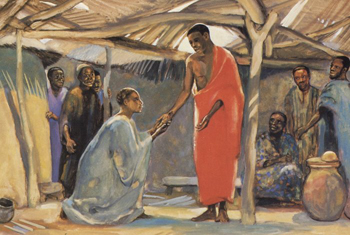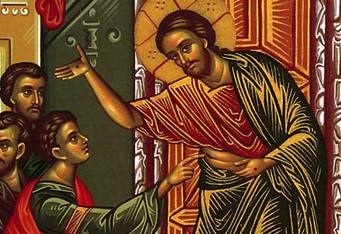For Sunday April 11, 2021
Lectionary Readings (Revised Common Lectionary, Year B)
Acts 4:32-35
Psalm 133
1 John 1:1-2:2
John 20:19-31
At the end of our Gospel reading this week, the author explains that while he had many stories, signs, and wonders to select from for his book, he chose the particular ones he did for a single, all-important reason: “So that you may come to believe that Jesus is the Messiah, the Son of God, and that through believing you may have life in his name.”
I, for one, am grateful. In this first week after Easter, I’m grateful that the writer of John’s Gospel deemed the story of “Doubting Thomas” an essential one to help us “come to believe.” I love that a mere seven days after we shout, “Alleluia!” and sing, “Christ the Lord is Risen Today!” John invites us to face our doubts, speak our fears, and yearn for more — more intimacy, more encounter, more experience of the living, breathing Christ.
Thanks to the story of Thomas, we’re invited to say the "heretical" thing we might very well feel as we descend from the mountaintop of Easter euphoria: “Unless I see him for myself, I won’t believe.” What a fierce, in-your-face response to the possibility of resurrection! What an audacious thing to want, to experience the empty tomb for ourselves. To say, “I need to become a witness in my own right. I need my own story of radical encounter. I want Jesus’s resurrection — if it’s real at all — to become real for me.”
How many of us go our entire lives without ever yearning as boldly as Thomas did?
In the footsteps of the doubting disciple, we're invited to voice our desires and raise our hopes. We’re given permission to feel hungry, cautious, and (dare we admit it?) envious. Envious of those who find faith easier to sustain than we do. Envious of those who have experienced Jesus more dramatically than we have. Envious of those who, for whatever reason, don’t feel the cognitive dissonance between the truth of the resurrection, and the ongoing reality of death in the world.
Thomas reassures us that our glorious Easter hymns notwithstanding, the week after the resurrection has always been murky, messy, and complicated. We’re not the first human beings to struggle with it, and we won’t be the last. Struggle is intrinsic to post-Easter life.
 |
When I was growing up, Thomas always got a bad rap in sermons and Sunday School lessons. I was taught quite explicitly to not be like him. He was deemed the cynic, the holdout. His reluctance to accept the testimony of his fellow disciples, his insistence on physical proof, his late arrival to the joyous belief of his peers— these were held up as spiritual flaws. As signs of stubbornness, or of a weak faith.
But weakness is not what I see in Thomas. I see a man who desired a holy and beautiful thing — a living encounter with Jesus. A man who wouldn’t settle for someone else’s experience of resurrection, but stuck around in the hope of having his own. A man who dared to confess uncertainty in the midst of those who were certain. A man who recognized his Lord in scars, not wonders.
According to John’s Gospel, Thomas had to wait in suspense and uncertainty for a whole week after his friends first told him they’d seen Jesus. What, I wonder, did that week feel like for the disciple who missed Jesus the first time around? Did he fear (as I so often do) that he’d missed the memo, missed the boat, missed the glory? That he was destined only ever to know God secondhand?
What strikes me most about Thomas’s story is not that he doubted, but that he did so publicly, without shame or guilt, and that his faith community allowed him to do so. And what I love about Jesus’s response is that he met Thomas right where he was, freely offering the disciple the testimony of his own scars, his own pain. After such an encounter, I can only imagine the tenderness and urgency with which Thomas was able to repeat Christ’s words to other doubters: “Blessed are those who have not seen, and yet have believed.” Because isn’t this all of us, on the Sunday after Easter? Don’t we all wrestle with hidden doubts, hidden fears? Don’t we all wonder sometimes if the miracle of resurrection will hold in Ordinary Time?
 |
Thomas’s story reminds me that resurrection is hard. It was hard from the get-go, and it’s still hard now. Hard to accept, hard to internalize, and hard to apply to our lives — especially when our lives are marked by pain, loss, uncertainty, and death. If nothing else, Thomas reassures me that faith doesn’t have to be straightforward; the business of accepting the resurrection, of living it out, of sharing it with the world, is tough. It’s okay to waver. It’s okay to take our time. It’s okay to hope for more.
John’s desire for his readers was that they would come to believe. That they would consent to the process, the path. The implication is that belief is not instantaneous. I've hardly ever experienced sudden transformation; the changes that matter most have always come sideways and in fits and starts, often without my conscious understanding or effort. Anyone who has battled an addiction, or stuck it out in a challenging relationship, or lived with a chronic illness, will testify that genuine conversion is lifelong. Maybe this is why the earliest Christians referred to their new faith as "The Way." A "way" is not a destination. It's a road to walk. It's an invitation to journey.
John chose an encounter between doubts and scars to help us come to belief, and this year — maybe more than ever — I cherish his choice. Why? Because this is territory I recognize after the past fourteen months of Covid, social isolation, racial injustice, gun violence, and political strife. Though we are a resurrection people, we are also a people in pain. The world around us is still wounded, and the scars we’re carrying from this past year will likely last a long time.
In these circumstances, Jesus’s scarred body resonates for us in so many ways. We recognize his scars in the people suffering the debilitating symptoms of “long Covid.” We see them in the faces of those who have lost loved ones to the disease. We watch them bleed afresh in the victims of gun violence. We see the damage they’ve caused in the divisive ugliness of our politics. This year in particular, Thomas moving his fingers across Jesus’s scars to experience a birthing of faith is searing. If we reflect on it long enough, it may bring us to our knees. Jesus and his scars are everywhere.
| |
So. If you’re finding the joy of Easter difficult to access right now, rest in the fact that Thomas took his time. Lean into the amazing truth that Jesus allowed him to do so. Hang onto the fact that Jesus opened a way for Thomas through the marks of his own suffering and trauma, sharing his broken body so that Thomas could find his way to wholeness. Consider the impact and the attractiveness of a faith community that holds space for the wary and the skeptical. Contemplate the wonderful story of a determined doubter who gradually found his way to faith, who came to see the Wounded One as Lord and God in his own time.
The story that comes after Easter is a story of scars and doubts. This is a tremendous gift; ponder it. “So that you may come to believe.”
Debie Thomas: debie.thomas1@gmail.com
Image credits: (1) RevGalBlogPals; (2) Greek Orthodox Metropolis of Detroit; and (3) The Daily Feast.





